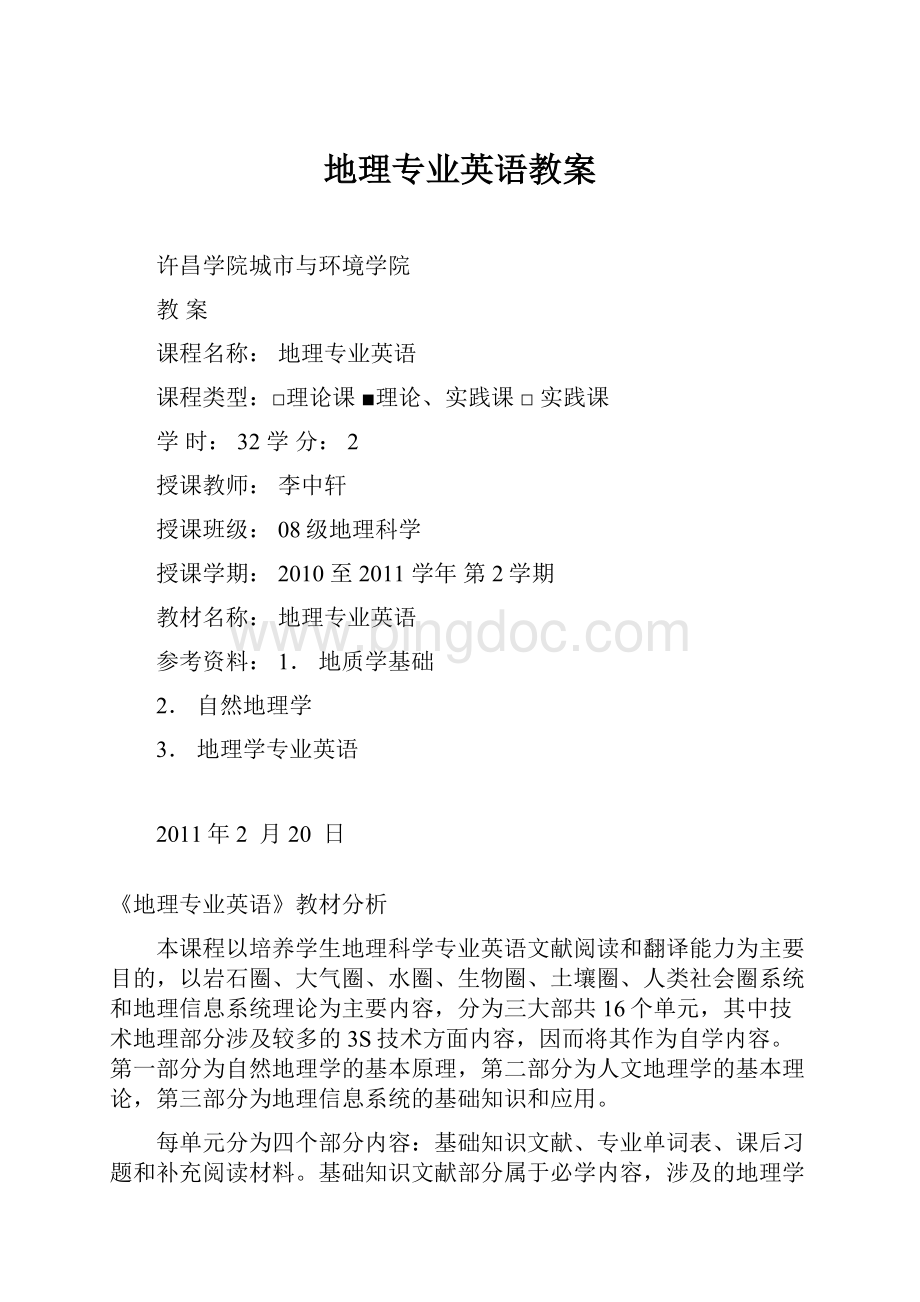地理专业英语教案.docx
《地理专业英语教案.docx》由会员分享,可在线阅读,更多相关《地理专业英语教案.docx(38页珍藏版)》请在冰点文库上搜索。

地理专业英语教案
许昌学院城市与环境学院
教案
课程名称:
地理专业英语
课程类型:
□理论课■理论、实践课□实践课
学时:
32学分:
2
授课教师:
李中轩
授课班级:
08级地理科学
授课学期:
2010至2011学年第2学期
教材名称:
地理专业英语
参考资料:
1.地质学基础
2.自然地理学
3.地理学专业英语
2011年2月20日
《地理专业英语》教材分析
本课程以培养学生地理科学专业英语文献阅读和翻译能力为主要目的,以岩石圈、大气圈、水圈、生物圈、土壤圈、人类社会圈系统和地理信息系统理论为主要内容,分为三大部共16个单元,其中技术地理部分涉及较多的3S技术方面内容,因而将其作为自学内容。
第一部分为自然地理学的基本原理,第二部分为人文地理学的基本理论,第三部分为地理信息系统的基础知识和应用。
每单元分为四个部分内容:
基础知识文献、专业单词表、课后习题和补充阅读材料。
基础知识文献部分属于必学内容,涉及的地理学知识大多已经在专业课中学过,对于大三同学而言并不陌生。
关键是文献中使用大量专业词汇,这对学生而言需要花费更多的力气去过单词关,对于一个将来需要进一步深造的本科生来说是必须的和必要的知识储备。
文献部分需要认真阅读,并能复述出文献的主要观点,同时在课堂讨论中有自己的认识和独到观点,并且能够进行口语表达。
课后作业内容可以提前在预习时完成,将疑难问题放到课堂上经过讨论后解决。
每个课时都安排约30分钟作为学生的讨论和回答问题时间,也可以按照单元进度开展对应的口语交流,以提高对专业英语文献的理解和应用技能。
《专业英语》是地理科学专业的一门必修课。
本课程的目的是使学生在进行了两年的公共英语学习后,在巩固已有知识的基础上,掌握科技英语的特点,具备教好的英语资料查阅及专业英语交流的能力。
也就是说,开设本课程,主要是让学生具备“以英语为工具通过阅读获取专业所需信息的能力”。
通过本课程的学习,学生应在科技词汇、专业英语文献阅读速度、准确理解和翻译专业文献、摘要写作上有较大的提高。
地理专业英语课程教案
授课题目:
Unit1TheEarthandtheUniverse
教学时数:
2
授课类型:
■理论课□实践课
教学目的、要求:
1.Vocabulary:
Jupiter,Saturn,Uranus,Neptune,Pluto,comet,asteroid,meteoroid,interplatarymedium,electromagnetic,dwarfstar,ProximaCentauri,
2.Sentences:
①SolarsystemconsistsofanaveragestarwecalltheSun,theplanetsMercury,Mercury,Venus,Earth,Mars,Jupiter,Saturn,UranusandNeptune.②TheSunistherichestsourceofelectromagneticenergy(mostlyintheformofheatandlight)inthesolarsystem.
教学重点:
1.Oraldepictingthedifferencebetweenterrestrialplanetsandjovianplanets.
2.Talkingaboutthereasonwhypeopleareinterestedinthemoonexploring.
教学难点:
1.Usingoflotsofnewspecializedwords
2.Oralcommunicationabouttheorbitsandperiodicalsofplanetsinsolarsystem.
教学方法和手段:
1.讲授法
2.分组讨论法
教具安排:
1.八大行星示意图
2.关于行星运动的视频资料
教学条件:
多媒体教室
参考资料:
1.BBC公司的太阳系视频
2.霍金著《时间简史》
其它:
第1页
地理专业英语课程教案
教学内容及过程:
旁批
教学引入:
1.playvideoofsolarsystemfor10minutes
2.Individualtalkingaboutthestoryhappenedinthesolarsystem.
3.LeadingstudentstofocusingthetextatPage2.
教学内容与教学设计:
I.SolarSystem
KeyPoint:
thedifferencebetweenterrestrialplanetsandJovianplanetsinSolarsystem;TrytodescribetheworldontheMoonorally.
II.EvolutionoftheUniverse
KeyPoint:
BigBangTheoryoftheUniverse;EarlyhistoryoftheEarth.
III.Assorttheclassintofourgroupstodiscusstheoriginofthesolarsystem,8planetsandtheirvolume,revolutionandperiodicals.
IV.AnswercorrespondingquestionsatPage7inpair
V.TalkingaboutcompositionofthefeaturesoftheterrestrialplanetsandtheJovianplanets
VI.ReadingthesupplementarymaterialatPage9
Answer:
1.WhydomostscientistsacceptthebigBangtheory?
2.HowwilltheUniverseend?
3.WhatabouttheearlyhistoryoftheEarth?
4.TalkingabouttheMoonexploring.
作业布置:
I.Vocabulary:
theAndromedaGalaxy,intergalacticspace,ecliptic,theJovianPlanet,MilkWay,counter-clockwise,lightyear,innermost;
II.Comprehension:
1.RetellthesolarsystemandevolutionstoryoftheEarth.
2.KnowingwellthecompositionoftheUniverse.
课后小结:
Moststudentshaveapoorstateofgraspingthewordsfollowedthetextandsopre-studybeforeclassisveryimportant.
第2页
地理专业英语课程教案
授课题目:
Unit2TheMovementoftheEarth
教学时数:
2
授课类型:
■理论课□实践课
教学目的、要求:
1.Vocabulary:
meansolarday,theNorthPole,earthrevolution,celestialmotion,perihelion,aphelion,tiltoftheEarth’sAxis,perpendicular,summersolstice,wintersolstice,theautumnalequinox,planeoftheecliptic;
2.Sentences:
①ThetermEarthrotationreferstothespinningoftheEarthonitsaxis.Onerotationtakesexactlytwenty-fourhoursandiscalledameansolarday.②ThiscircumstanceisresponsiblefortheannualchangesintheheightoftheSunabovethehorizon.
教学重点:
1.DescribethemechanismoftherevolutionoftheEarth.
2.Describethevariationofdaylengthandthedrivingfactors.
教学难点:
1.Howdepicttheseasonalchangeandtheearthrevolution.
2.CalculatingtheheightangleoftheSuninlightofdifferentlatitudes.
教学方法和手段:
1.自学提问法
2.分组讨论法
教具安排:
1.地球自转和公转示意图
2.自制的四季许昌的太阳高度表
教学条件:
多媒体教室
参考资料:
1.自然地理学
其它:
第3页
地理专业英语课程教案
教学内容及过程:
旁批
教学引入:
1.AbriefreviewofthestoryoftheEarthandtheEvolutionoftheUniverse
2.talkingabouttheseasonalchangeandvariationsoftheSunHeight.
3.ReadingthetextatPage17.
教学内容与教学设计:
I.Earthrotationandrevolution
KeyPoints:
thecharacteristicsoftheEarth’sRotationandRevolution;RetelltheprocessoftheEarth’sRevolutioninayear.
II.AxisTiltandSolarAltitude
KeyPoints:
narratetheprincipleofmeasuringSolarnoonangle;relationshipofmaximumSunheighttolatitudeforequinoxandsummersolstice.
III.AssorttheclassintofourgroupstodiscussthedifferencesoftheEarthrotationandrevolution.
IV.AnswercorrespondingquestionsatPage21inpair
V.Discussingthelocationanddirectionoftheearthaxis,anditsdirectresultsfortheearth’smotion.
VI.ReadingthesupplementarymaterialatPage25
Answer:
1.what’stheresultsindifferentsolaraltitude?
2.what’sthechangeofthesolaraltitudeifobliquityoftheeclipticisupright?
3.Talkingaboutthevernalequinoxandsummersolstice.
作业布置:
I.Vocabulary:
tiltoftheEarth’sAxis,perpendicular,summersolstice,wintersolstice,theautumnalequinox,planeoftheecliptic;
II.Comprehension:
1.RetellthesolarsystemandevolutionstoryoftheEarth.
2.KnowingwellthecompositionoftheUniverse.
课后小结:
Helpstudentsuseproperspecializedwordsandexpressions,meanwhileencouragethemusingEnglishonclassaspossible.
第4页
地理专业英语课程教案
授课题目:
Unit3TheStructureoftheEarth
教学时数:
2
授课类型:
■理论课□实践课
教学目的、要求:
1.Vocabulary:
seismic,mantle,crust,basalt,granitic,oceaniccrust,peridotite,olivine,pyroxene,asthenosphere,lithosphere,mountainbuilding,
2.Sentences:
①Thecoreisalayerrichinironandnickelthatiscomposedoftwolayers:
theinnerandoutercores.②Bothofthesecrusttypesarecomposedofnumeroustectonicplatesthatfloatontopofthemantle.Convectioncurrentswithinthemantlecausetheseplatestomoveslowlyacrosstheasthenosphere.
教学重点:
1.GraspthestructureofthelithosphereoftheEarth.
2.RetellthePlatetectonictheoryandfeaturesoftheoceancrustandcontinentalcrust.
教学难点:
1.Understandingoftheinfluencingfactorsofcontinentalbuildingandvolcanoes.
2.Comparisonandanalysisofthecompositesofthemantleandcrust.
教学方法和手段:
1.自学探讨法
2.分组讨论法
教具安排:
1.地球的内部结构图
2.海陆构造结构示意图
教学条件:
多媒体教室
参考资料:
1.自然地理学
2.地质学基础
其它:
第5页
地理专业英语课程教案
教学内容及过程:
旁批
教学引入:
1.Areviewofthesolaraltitudeanditsinfluencesonregionalclimate
2.playingvideoofevolutionofoceanandcontinent.
3.CarefullyReadthetextatPage31.
教学内容与教学设计:
I.LayersoftheEarth
KeyPoints:
graspdetailedlayersoftheearth;understandthestructureoftheEarth’scrustandtopmostlayeroftheuppermantle.
II.PlateTectonics
KeyPoints:
understandthecreationofoceaniccrustontheoceanfloor.KnowthebasicknowledgeaboutconvectioncurrentsintheEarth’smantleandtheirroleinoceaniccrustformationanddestruction.
III.Therockcycle
KeyPoints:
understandmechanismofhowrocksareformedanddestroyed.Primarilygraspclassifiedmethodofigneousrocks.
IV.Assorttheclassintofourgroupstodiscussthedifferencesofthemantleandcrustoftheearth.
V.AnswercorrespondingquestionsatPage42inpair
VI.Discussingthelocationanddirectionoftheearthaxis,anditsdirectresultsfortheearth’smotion.
VII.ReadingthesupplementarymaterialatPage43
Answer:
1.Howmanylayersarethereoftheearth,theirfeatureandcomposites?
2.what’sthedifferencesoftheoceancrustandcontinentalcrust?
3.whyisthecontinentcrustthickinthemountainranges?
作业布置:
I.Ex.1,2onPage37
II.Comprehension:
1.translatethe3rdparagraphatPage41.
2.Describingthethreeepisodesontheborderofthetwoplate.
课后小结:
Puttingforwardagoodquestionisthekeytoorganizeclassdiscussion.
第6页
地理专业英语课程教案
授课题目:
Unit4SoilsandPlants
教学时数:
2
授课类型:
■理论课□实践课
教学目的、要求:
1.Vocabulary:
pedogenesis,evapotranspiration,precipitation,organicmatter,decomposition,livingorganism,biogeochemical,litterfall,humus,residual,soiltexture,
2.Sentences:
①Thisideawasbasedontheobservationthatcomparablesoilsdevelopedinspatiallyseparateareaswhentheirclimateandvegetationweresimilar.②Surfacevegetationbindsthesoilssurfaceandreducesthespeedofmovingwindandwateracrossthegroundsurfaceprotectingtheupperlayersofasoilfromerosion.
教学重点:
1.Understandthegenesiselementsofsoil.
2.Principlepedogenicprocessesinspace.
教学难点:
1.seriesofchemicalprocessesinpedogenesis.
2.Explainthespatialdistributionofsoilunderdifferentchemicalclimatecondition.
教学方法和手段:
1.讲授法启发
2.分组讨论法
教具安排:
1.土壤圈层图
2.自绘土壤形成的影响因子示意图
教学条件:
多媒体教室
参考资料:
1.自然地理学
2.土壤地理学
其它:
第7页
地理专业英语课程教案
教学内容及过程:
旁批
教学引入:
1.Reviewofplatetectonictheoryanditsapplication.
2.Letstudentstalkthesoilkindsofhisnativetown.
教学内容与教学设计:
I.SoilPedogenesis
Keypoints:
understandthefactorsthateffectthesoilpedogenesis;retellfluentlytheprocessesofrockerosionandtheroleofclimate.
II.CharacteristicsoftheEarth’sTerrestrialBiomes
Keypoints:
inEnglishretellthedifferentbiomesfromtheTropicalzonetotheArcticorAntarcticareasaswellasitscorrespondentmechanism.Atleastnarrateoneofparagraphsaboutdescriptionofbiomesinmid-orlow-altitudeareas..
III.Classifytheclassintofourgroupstodiscussthedifferenteffectingfactorsof